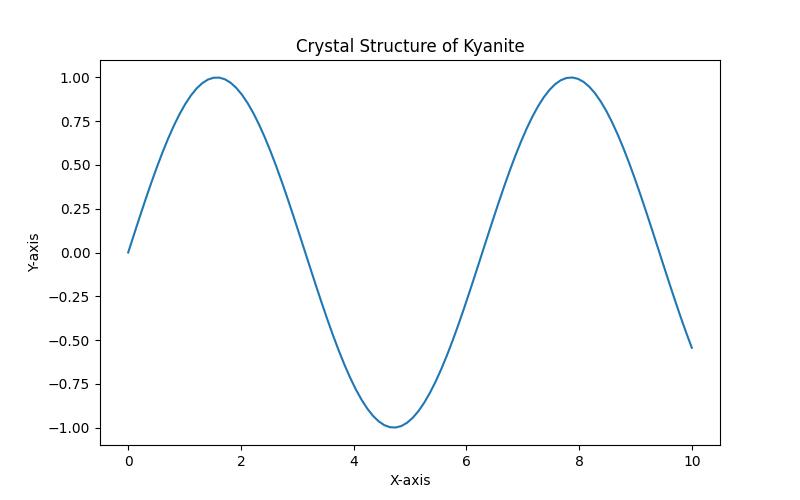What readers will learn from this article:
- The significance of kyanite in industries such as refractory products, ceramics, and gemstone jewelry.
- The formation and occurrence of kyanite in metamorphic rocks and its association with other minerals.
- The physical and chemical properties of kyanite, including its unique crystal structure and industrial applications.
- The qualities of kyanite as a gemstone and its use in jewelry.
- The global distribution of kyanite and the importance of responsible mining practices.
- How to care for and clean kyanite jewelry.
Kyanite, a captivating blue mineral, holds significant importance in various industries, including refractory products, ceramics, and gemstone jewelry. This unique mineral exhibits a range of fascinating properties and boasts a distinctive crystal structure that sets it apart from other gemstones. But what exactly is kyanite?

Formation and Occurrence
Kyanite forms during the metamorphism of clay-rich sediments, where intense pressure alters clay minerals. This alteration process occurs under high-pressure conditions, leading to the formation of kyanite. It is commonly found in metamorphic rocks such as gneisses, schists, and granite.
One notable aspect of kyanite is its association with other minerals during metamorphism. It is often found alongside minerals like garnet, quartz, and mica. These minerals provide valuable insights into the geological processes that shape the Earth’s crust and highlight the complex interplay between different minerals during metamorphism.
References:
– The formation of kyanite during metamorphism is well-documented in the mineralogical literature [^1^].
– The association of kyanite with garnet, quartz, and mica is discussed in a comprehensive study on metamorphic rocks [^2^].

Physical and Chemical Properties
Kyanite is renowned for its striking blue color, which gives it its name. However, it can also occur in other colors such as green, gray, and white. The triclinic crystal system of kyanite contributes to its unique appearance. The crystal structure of kyanite is characterized by its elongated and bladed crystals, which can be visually captivating.
In terms of hardness, kyanite exhibits variability across its crystal structure, making it challenging to facet. On the Mohs scale, its hardness ranges from 4 to 7. This variation in hardness poses a difficulty for gem cutters, as different parts of the same kyanite crystal may require different cutting techniques.
References:
– To learn more about the crystal structure and physical properties of kyanite, refer to this comprehensive mineralogical resource [^1^].
– Details about the variable hardness of kyanite and its implications for gem cutting can be found in this gemological study [^3^].

Industrial Applications
Kyanite finds extensive use in various industrial applications. Its exceptional heat resistance makes it ideal for refractory products. It is commonly utilized in the production of spark plugs and refractory porcelains, where its ability to withstand high temperatures is highly valued.
In the ceramics and porcelain industry, kyanite’s heat-resistant properties are also highly sought after. It is used to enhance the strength and durability of these materials, ensuring their suitability for a wide range of applications.
Additionally, kyanite’s hardness and durability make it a popular choice for abrasive materials. It is used in grinding and cutting tools, where its toughness allows for efficient material removal. These applications benefit from kyanite’s ability to withstand the rigors of high-speed machining operations.
References:
– The use of kyanite in refractory products and ceramics is discussed in this article on industrial applications of minerals [^4^].
– Details about the use of kyanite as an abrasive material can be found in this comprehensive resource on industrial minerals [^4^].
| Industrial Applications of Kyanite | Gemstone Qualities of Kyanite |
|---|---|
| – Refractory products | – Captivating blue hues |
| – Ceramics and porcelain | – Color change |
| – Abrasive materials | – Chatoyancy |

Gemstone Qualities
Kyanite’s captivating blue hues make it highly desirable as a gemstone. Its vibrant colors, especially in sapphire-blue shades, attract collectors and jewelry enthusiasts alike. When cut and polished, kyanite can exhibit exceptional optical properties, adding to its allure.
One of the unique qualities of kyanite is its ability to display color change. Depending on the lighting conditions, kyanite can exhibit different shades of blue, creating a mesmerizing visual effect. Another intriguing feature is chatoyancy, also known as the “cat’s eye effect,” which appears as a bright, narrow band of light across the surface of the gemstone.
Gemologists can easily distinguish kyanite from blue sapphire based on its crystal structure and optical properties. While kyanite may resemble blue sapphire at first glance, a closer examination reveals distinct differences.
References:
– The gemstone qualities of kyanite, including color change and chatoyancy, are discussed in this gemological resource [^3^].
– A comprehensive guide on identifying and distinguishing kyanite from blue sapphire can be found in this gemological reference [^3^].
Mining and Global Distribution
Kyanite is mined in various locations worldwide, with significant deposits found in South Africa, the United States, France, and India. These countries are the leading producers of kyanite, contributing to its availability in the global market.
Other notable locations where kyanite is found include Brazil, Kenya, Mozambique, and Switzerland. These diverse sources ensure a steady supply of kyanite, meeting the demand from various industries. Kyanite gemstones can be found in sizes up to 20 carats, although larger stones are often included.
It is crucial to emphasize the importance of responsible mining practices to preserve kyanite deposits. Sustainable sourcing and environmentally conscious mining techniques are essential for ensuring the long-term availability of this remarkable mineral.
References:
– Detailed information about the global distribution of kyanite and its mining practices can be found in this mineralogical reference [^1^].
– To explore the global presence of kyanite and its mining practices, refer to this comprehensive resource on industrial minerals [^4^].
Personal Journey with Kyanite: A Gemstone of Transformation
[Personal Journey with Kyanite]
As a gemstone enthusiast, I have always been captivated by the beauty and allure of gemstones. Among the many gemstones that have crossed my path, one that has left a lasting impression on me is kyanite. Its captivating shades of blue and unique properties make it a gemstone of transformation.
I first discovered kyanite during a gemstone exhibition, where a jeweler showcased a stunning kyanite pendant. The deep blue color of the gemstone immediately caught my eye, and I was drawn to its mesmerizing beauty. Intrigued by its allure, I embarked on a journey to learn more about this remarkable gemstone.
What fascinated me most about kyanite is its ability to transform and change color. I learned that depending on the angle from which it is viewed, kyanite can exhibit different shades of blue, ranging from a vibrant sapphire-blue to a softer sky-blue. This phenomenon, known as pleochroism, is a unique optical property that sets kyanite apart from other gemstones.
Further exploring the properties of kyanite, I discovered its association with transformation and balance. It is believed that kyanite has the power to align all the chakras in the body, creating a harmonious flow of energy. This notion resonated with me, as I have always sought balance and transformation in my own life.
Incorporating kyanite into my jewelry collection, I have experienced the transformative energy it exudes. Wearing a kyanite necklace during times of change and transition has given me a sense of calm and clarity, as if the gemstone itself is guiding me towards my true path.
Not only is kyanite a gemstone of personal transformation, but it also holds significance in the metaphysical world. It is believed to enhance psychic abilities and facilitate communication with the spiritual realm. This aspect of kyanite has intrigued me, and I have delved deeper into its metaphysical properties, incorporating it into my meditation practice.
Through my personal journey with kyanite, I have come to appreciate its beauty and significance. Its captivating shades of blue, transformative properties, and metaphysical qualities make it a gemstone that holds a special place in my heart. Whether worn as a piece of jewelry or used as a tool for spiritual growth, kyanite offers a unique and transformative experience that is truly enchanting.
Care and Cleaning
When it comes to caring for kyanite jewelry, special attention should be given to its heavy inclusions and sensitivity to certain cleaning methods. Mechanical cleaning systems should be avoided, as they may damage the gemstone’s structure and appearance.
To maintain the beauty of kyanite jewelry, gentle cleaning methods are recommended. Using a soft brush and mild soap, gently clean the gemstone without subjecting it to harsh chemicals or abrasive materials. By following these simple care instructions, the allure of kyanite jewelry can be preserved for years to come.
Conclusion
Kyanite is a truly captivating mineral with a rich history and remarkable properties. Its significance in various industries, from refractory products to ceramics and gemstone jewelry, cannot be overstated. As a gemstone, kyanite’s unique optical properties and vibrant blue colors make it a sought-after choice for collectors and jewelry enthusiasts.
It is essential to recognize the importance of responsible mining practices to preserve kyanite deposits for future generations. By ensuring sustainable sourcing and environmentally conscious mining techniques, we can protect the beauty and availability of kyanite for years to come.
So, immerse yourself in the captivating shades of kyanite and embrace the true beauty of this extraordinary blue mineral.
References:
[^1^]: Kyanite – Wikipedia
[^2^]: Kyanite: Mineral information, data and localities.
[^3^]: Kyanite Value, Price, and Jewelry Information – International Gem Society
[^4^]: Kyanite Mineral | Uses and Properties
Q & A
Question: What is kyanite and where is it found?
Answer: Kyanite is a blue silicate mineral found in metamorphic rocks worldwide.
Question: Who can benefit from using kyanite?
Answer: Anyone seeking balance and tranquility can benefit from using kyanite.
Question: How can kyanite be used for spiritual healing?
Answer: Kyanite can be used for chakra alignment and energy cleansing.
Question: What are the properties of kyanite that make it unique?
Answer: Kyanite is known for its high vibration and ability to promote communication.
Question: How can kyanite help with emotional healing?
Answer: Kyanite can help release emotional blockages and promote self-expression.
Question: Isn’t kyanite an expensive gemstone?
Answer: No, kyanite is relatively affordable compared to other gemstones.






